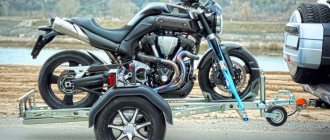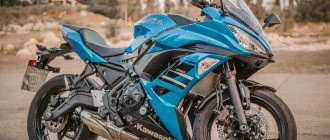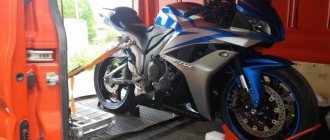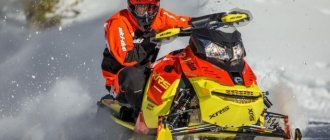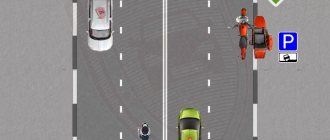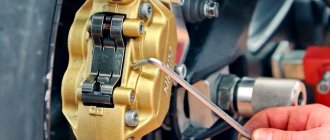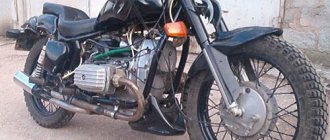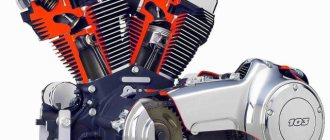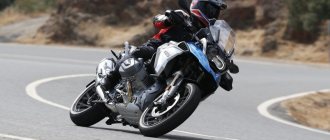Good afternoon, dear reader.
This article will discuss the rules of the road for motorcycle drivers.
I would like to note right away that, in general, the rules for motorcyclists are not very different from the rules for passenger cars, so only their main differences will be discussed below.
Let me remind you that earlier on “Traffic Rules Master” the rules for bicycles and mopeds were discussed.
What vehicles are classified as motorcycles?
First of all, let's look at paragraph 1.2 of the traffic rules, which defines the concept of a motorcycle:
“Motorcycle” is a two-wheeled motor vehicle with or without a side trailer, the engine displacement of which (in the case of an internal combustion engine) exceeds 50 cc. cm or the maximum design speed (with any engine) exceeds 50 km/h. Motorcycles are considered tricycles, as well as quadricycles with a motorcycle seat or motorcycle-type handlebars, having an unloaded weight not exceeding 400 kg (550 kg for vehicles intended for the transport of goods), excluding the weight of batteries (in the case of electric vehicles), and the maximum effective engine power not exceeding 15 kW.
So, motorcycles include two-wheeled vehicles that have one of the following characteristics:
- The maximum speed exceeds 50 km/h.
- Engine volume exceeds 50 cm3.
Note. A vehicle whose maximum speed is less than 50 km/h and whose engine capacity does not exceed 50 cm3 is a moped from the point of view of traffic regulations.
In addition, motorcycles include three-wheeled and four-wheeled vehicles that:
- They have a motorcycle seat or motorcycle-type handlebars.
- Have an unladen weight of 400 kg or less (550 kg for commercial vehicles) excluding battery weight. This value is indicated in the “Weight without load, kq” field on the back of the registration certificate.
- Have a maximum effective motor power of 15 kW or less.
Driver's license for a motorcycle
To drive a motorcycle, a driver's license of one of the following categories is suitable:
- A1 - only for motorcycles with engine capacity up to 125 cm3 and power up to 11 kW inclusive.
- A - for any motorcycles.
Categories and subcategories of driver's licenses
However, the traffic rules for motorcycles of subcategory A1 and category A do not differ.
How a car and a motorcycle should move in the same lane
A motorcycle is not prohibited from changing lanes with a car according to the set of traffic rules. There is no prohibition on such a maneuver, even if there are markings (solid/intermittent). Then the participants move in two rows. This does not conflict with the rules. They do not stipulate that it is necessary to move along the lane one at a time (this also applies to the movement of two cars). Regarding the question of whether a motorcycle can ride between the rows, we conclude that a biker is not allowed to move between the rows in every case. This is only relevant for driving options along the marking line itself. If the road is unmarked, then a two-wheeled vehicle has the right to form a new lane, taking into account the dimensions of the vehicle. It is also not prohibited for him to move with the car between the marking lines within the boundaries of one lane. See the picture for the movement diagram.
Pedestrian driving a motorcycle
“Pedestrian” is a person who is outside a vehicle on the road or on a pedestrian or bicycle path and is not working on them. Persons moving in wheelchairs, driving a bicycle, moped, motorcycle, carrying a sled, cart, baby or wheelchair, as well as using roller skates, scooters and other similar means for movement are considered pedestrians.
A motorcycle driver, like cyclists and mopedists, can become a pedestrian at any time. To do this, he just needs to get off the motorcycle and drive the motorcycle next to him.
Motorcyclists can use this technique for their convenience:
For example, a motorcycle is driving along a country road that has a dividing strip. He wants to turn left (to the village), but turning left is impossible because a median fence runs through the intersection. Therefore, the motorcyclist is forced to drive straight and turn around after a few kilometers along a special turning loop.
However, there is another option - to dismount and cross the road at a pedestrian crossing, which is located next to a public transport stop.
In addition, you need to remember that a pedestrian driving a motorcycle on the roadway must move along the flow of vehicles, i.e. on the right side of the road. Paragraph 4.1 of the traffic rules:
When walking along the edge of the roadway, pedestrians must walk towards the movement of vehicles. Persons moving in wheelchairs, driving a motorcycle, moped, bicycle, in these cases must follow the direction of travel of the vehicles.
Friends, I present to your attention my modest work on motorcycle driving safety, which was written a year and a half ago. All the tips, safety principles and recommendations that I managed to collect over several years are collected here. I put my soul into this and I will be happy if the book helps make riding a motorcycle safer. I will be glad if you have something to add, if you have comments, if you disagree with something, if you have a special opinion or want to share your experience. Let's write it together... If anything, my mailbox Considering the BikePost format, I will send one or two chapters so that people can express their opinion. Thanks in advance. Let's go... Sad statistics: In 2009, from May to October, there were more than 17,000 accidents involving motorcyclists. Drivers on two wheels are more often blamed for such accidents (in 13,000 cases). 1,509 people were killed in them, 19,581 (!) were injured in the event of an accident, motorcyclists die 22 times more often than drivers and passengers of cars. And the risk of serious injury is already 40 times higher. Be careful!
Chapter 1. Equipment and protection • Equipment is the most important thing in motorcycle riding, start with it. • Do you want to be alive and healthy? Even if you are going to a bakery five hundred meters away, wear all your equipment. • A helmet is mandatory, without exception, always, there is no other option. • If you are wondering whether or not to wear a helmet, for example, for a short trip, try hitting your head against a wall at a fast walking speed (8 km/h). Hurt? What if the speed is 40 km/h? • Well, okay, I didn’t hit myself, because I’m lucky and careful. What if, at a speed of 60 kilometers per hour, your eye catches a bug or a pebble from under a wheel? • If you are thinking about whether to wear gloves, remember that at a speed of 5 km/h when sliding on your hands, you will leave your skin on the asphalt and will be forced to build it up again. Skin grafting from the thigh to the palm is also painful. • Be visible on the road - choose bright equipment, especially a helmet • In traffic jams, do not open the visor completely - many motorcyclists get windshield wiper fluid in the face when the driver turns on the windshield washer on a nearby car. • Be sure to wear motorcycle boots, at least light ones. It is also very advisable to use motorcycle pants for their intended purpose, and not in the closet. Broken legs (especially if the ankle, pelvis and knees are affected) are very difficult to assemble and heal.
Chapter 2. General principles of driving • FIRST RULE: TAKE RESPONSIBILITY FOR EVERYTHING THAT HAPPENS TO YOU ON THE ROAD. Even if that weirdo with the letter “m” is wrong. Because if you are dead, you no longer care who is to blame in a particular traffic situation. Everything depends only on you. Learn to drive not according to traffic rules, but learn to drive without accidents, regardless of who is doing what on the road. • SECOND RULE: DRIVE AS LIKE NO ONE SEES YOU. NOBODY! • THIRD RULE: DON'T BE IMPRESSIVE AND DON'T FORGET. Most motorcycle accidents are caused by overconfidence, speeding, and lapses in caution. Be afraid of the situation when you start to think that you are a great motorcyclist. This means that you are in mortal danger. Lower your assessment of your abilities just below the level of your skills - move with a reserve. • There is no need to stir up fear in yourself, you just need to be attentive and careful. Driving in a state of terror and thinking about bad things is contraindicated, since fear fetters the mind and thoughts materialize. •Overtaking, maneuvering, speed – the basic rule: if you are not sure and in doubt, don’t do it!!! • Get into the habit of driving not like a fast vegetable (in gas-brake mode), but like a fast supercomputer - evaluate what you see around, play the “what if?” game, calculate the situation ahead of time, look for risks and escape routes. • Remember, no one owes you anything - move in traffic jams, give way, follow traffic rules especially for you that are ignored by other road users. This may not be very fair, but you will save nerve cells if you take this position. And sometimes your life. • Always keep your fingers on the brake and clutch levers - this will save you 15-20 meters of braking distance in a critical situation. • High beams in the city should be turned on, because you will be better noticed. There are several counterarguments to this concept: high beams can blind drivers and prevent them from correctly judging the distance to the motorcycle and its speed. But high beams in the city have more advantages. I've heard of a few accidents caused by a driver being blinded by a motorcyclist, or when a distant motorcyclist was spotted but their speed was misjudged, but "I didn't notice" accidents form the basis of the sad statistics - there are many more of them. However, you need to behave correctly - if you are driving behind a car for a long time and do not intend to overtake it, then switch the headlight to low beam so as not to tire or irritate the driver. • Learn and master counter-steering. This method will allow you to be much more maneuverable in dangerous situations. Please note that counter-steering is used at speeds above “parking” speeds. • Train attentiveness - you may not be noticed, but you must control literally everything that happens on the road. If you feel that your attention has dulled, stop and take a break for 5-10 minutes. It's better to rest on the side of the road than in a hospital bed. • Never relax - most accidents happen within 5 kilometers of your home. • Avoid bravado in heavy traffic, for example, driving much faster than the flow, or horse riding on the rear and front wheels. Otherwise, it’s only a matter of time before your equipment is tested in battle. By the way, do not forget that on the road you are responsible not only for yourself. • There is such a phenomenon as “Gaze Fixation”, it consists in the fact that you often go where you are looking at the moment, and not where you need to go. Don't stare at objects you want to avoid, be it a pole, a hole, or a busty blonde. • Direct your gaze not at the wheels, but forward. The higher the speed, the further we look. •Train the fly in you – in the flow, don’t stop scanning and controlling the situation at 360 degrees, creating more visible space for yourself. • 77% of the danger for a motorcyclist lies in front (accident statistics), 43% is on the front left side. So distribute your attention, but don’t forget about the starboard side and stern. • In heavy traffic, you need to look at the road 3-4 cars ahead - the braking distance, plus a reserve for your reaction (slightly faster than that of a diplodocus). • Train yourself to look not only at the mirrors, but also to turn your head a little, because the mirrors have blind spots that can accommodate entire trucks. Turn your head like Pokryshkin in an air battle. • At the same time, do not turn your head more than necessary to make sure that a specific area is clear, otherwise you may wander off the path of your gaze (see the “Gaze Fixation” phenomenon). • Don’t stare at the mirrors for hours, like a supermodel in the boudoir: look, “photograph” the situation, turn your gaze to the road - at this time the brain itself will digest the picture and give the necessary solutions. • Don't let your eyes dwell on one object for more than a split second, there are still many interesting and dangerous things around. • Pay attention to the sun - when it is blinding, you may not see the car and, most dangerously, when the car is slowing down. • Pay attention to the position of the sun - when it is behind, the motorist may not see you through his rearview mirror, just as you will not see anything in your mirrors due to the blinding light. • No need to lean on the steering wheel - in case of an unforeseen situation it will be more difficult to maneuver. Your hands should be free enough, but you should feel that the steering wheel is controlled easily, without delay, by signals from your vast brain. Try rocking the steering wheel back and forth. • Don't drive if your head is full of problems, if you're tired and your attention is scattered. Tired eyes cling to one object. This is very dangerous - you can experiment and observe the speed of your reaction when you really want to sleep. • Do not drive while hungover or intoxicated. If you drive into the city drunk, you will get the car first of all; if you drive a motorcycle, it may be your last trip. If you don't care, then before you go on a drunken trip, at least call all your loved ones and ask for their forgiveness. • When leaving a closed area (forest, fence) to an open one (field), be careful - you can be blown away by a crosswind, like a sheet of plywood over Paris. • If the wind is sideways, use counter-steering and lean into the wind. Be careful - the gust of wind may suddenly stop, you need to balance back. • When trying to thank traffic participants who let you pass, do not be distracted from the controls and, moreover, do not remove your hands from the brake lever (especially in a traffic jam). You can nod your head, you can blink your emergency lights, in Europe they stick their leg out to the side, for example. • When a convoy of motorcyclists moves on the highway, it is better to break the convoy into small groups of 2-3 people who can maintain the same rhythm of movement. • When riding in a group or in heavy traffic, keep your distance - if a wall grows in front of you, you must have time to stop. • When driving in a group, or in heavy traffic, move slightly to the side of your friend’s track, this will save you from trouble if you are too lazy, or he brakes sharply.
Read part two
Is a helmet required on a motorcycle?
The issue of using a helmet on a motorcycle is regulated by clauses 2.1 and 5.1 of the traffic rules:
2.1. The driver of a motor vehicle is obliged to: ... 2.1.2. When driving a vehicle equipped with seat belts, be fastened and do not carry passengers who are not wearing seat belts. When driving a motorcycle, wear a fastened motorcycle helmet and do not carry passengers without a fastened motorcycle helmet.
5.1. Passengers are obliged to:
- when traveling in a vehicle equipped with seat belts, be wearing them, and when riding a motorcycle, wear a fastened motorcycle helmet;
That is, when riding a motorcycle, a helmet must be worn by both the driver and passengers. Including passengers traveling in a stroller (cradle).
How to maneuver between rows when there are no markings
It is difficult to navigate the applicable traffic rules when the road surface is not marked in any way. Let's consider several options:
- If the motorcycle and the car can fit across the entire width of the road, forming two rows and maintaining a distance sufficient for safety, taking into account the lateral spacing. This means no one violated the traffic rules.
- The point above only works if the vehicles do not collide with each other. If a motorist hits a biker, they consider that the lateral spacing was insufficient and unsafe. The reason may also be the incorrect alignment of one of the participants.
- There are even more complex conditions. When there are no markings on the road part, the road is automatically divided in half into oncoming and passing lanes. When a biker gets ahead of a car, he partially occupies the meeting. Then they believe that he is performing maneuvers between the rows. If, while ahead of the vehicle, their sides “rubbed” against each other, the biker will most likely be considered guilty.
- But this is relative, since the situation changes when an oncoming car appears. If all three vehicles fit on the roadway without colliding, then the interval between them is again considered safe. Then three rows are formed on the road, and the motorcyclist no longer moves between the rows.
Parking the motorcycle
Paragraph 12.2 of the traffic rules:
Parking on the edge of the sidewalk bordering the roadway is permitted only for cars, motorcycles, mopeds and bicycles in places marked with sign 6.4 with one of the signs 8.4.7, 8.6.2, 8.6.3, 8.6.6 - 8.6.9.
Just like cars, motorcycles can be parked in a sidewalk parking lot if there is a sign 6.4 with one of the following plates:
Transporting passengers on a motorcycle
22.21. Transportation of people on a motorcycle must be carried out by a driver who has a driver’s license for the right to drive vehicles of category “A” or subcategory “A1” for 2 or more years; transportation of people on a moped must be carried out by a driver who has a driver’s license for the right to drive vehicles of any category or subcategories for 2 or more years.
Only a driver who has 2 years or more of experience in category A or subcategory A1 can carry passengers on a motorcycle.
Note. This fact has nothing to do with the fact that the driver is a beginner.
For example, a driver has had a category B driving license for 20 years, that is, from the point of view of traffic rules, he is not a beginner. However, he recently received a motorcycle license, so he cannot carry passengers.
22.8. It is prohibited to transport people:
- outside the cabin of a car (except for cases of transportation of people in the back of a truck with a flatbed or in a van), tractor, other self-propelled vehicles, on a cargo trailer, in a caravan trailer, in the back of a cargo motorcycle and outside the seating areas provided for by the design of the motorcycle;
In addition, passengers are prohibited from being transported outside the designated areas.
For example, you cannot put a passenger on the trunk.
Pilot's instructions
The driver is the responsible person who determines how comfortable the trip will be for two. The health and lives of both are in his power. You must be able to maintain balance with the load, which requires special skill. Otherwise, there may be falls on the spot or while moving. Therefore, even if you are a strong single rider, you should practice riding together.
The best option is to take a biker friend with you and run it first off busy roads. He will suggest incorrect manipulations. After adjustments, you can go into the seething expanses of city streets without giving too much gas, constantly balancing. If the run-in goes well, feel free to offer a ride to others.
The rider should be warned that the motorcycle passenger’s clothing meets the requirements: thick trousers, jacket, gloves, glasses. You need boots that cover the ankle. Such equipment is selected regardless of the weather. Even if it’s warm outside, a speeding bike will cause a lot of trouble in its absence (at least a piercing wind). If a fall occurs, clothing can protect the body. To prevent damage to your bike, use motorcycle protection.
You need to tune in for trouble-free driving and feel confident. Otherwise, it’s better not to leave. If the passenger footrests were hidden, they should be bolted down. Make it clear that the legs are placed on them (exhaust pipes are excluded). It is important to remember that you should sit on the motorcycle with the side stand raised. After this, the transmission does not engage until the rider is seated.
You need to establish contact with him before the motorbike starts moving. Explain how to behave while moving: don’t twitch, don’t be afraid, try to follow your movements and repeat them, especially when turning. Develop conditioned signals such as: tap on the shoulder - slow down please, tap on the knee - stop.
Motorcycle towing
20.4. Towing is prohibited: ...
- two-wheeled motorcycles without a side trailer, as well as such motorcycles;
Towing involving two-wheeled motorcycles is prohibited by law.
However, it is not prohibited to tow motorcycles with a side trailer (cradle), three-wheeled and four-wheeled motorcycles:
Rules for towing vehicles
"Beginner Driver" sign on a motorcycle
In 2022, a driver who has less than 2 years of total experience is required to display a novice driver sign on the rear of the vehicle. does not apply to motorcyclists :
“Beginner driver” - in the form of a yellow square (side 150 mm) with an image of a black exclamation mark 110 mm high - behind motor vehicles (except for tractors, self-propelled vehicles, motorcycles and mopeds) driven by drivers who have the right to drive the specified vehicles less than 2 years old.
Traffic rules for novice drivers
Ban/permission for bikers to move between lanes in 2022 – new bill
In recent years, there has been active development of a law to tighten the liability of motorcycle owners. This applies to cases of non-compliance with lateral distances and maneuvering between rows. The latest bill proposes the introduction of a fine for bikers for driving between rows in the amount of up to 5 thousand rubles. The punishment may also be deprivation of rights for a period of 3-6 months. Discussions are still ongoing about possible changes to the traffic rules.
Assumptions about a ban on the movement of two-wheeled vehicles between lanes are absurd. Many sources have already published incorrect information that motorcyclists have already been banned from riding between rows. In fact, they are not allowed to move along the markings. Tougher rules are only being discussed in the State Duma. Occupying one row with a car, a biker can form a second row in the same lane, observing traffic rules.
Video on the topic:
